If your programming is centered around the bench press, squat, and deadlift and you have been chasing bigger and bigger numbers in these three lifts training session after training session, then regardless of whether you ever intend to compete or not you are basically a powerlifter. Well how’d you like to train at home rather than at the global gym?
There’s little doubt that thanks to Instagram, YouTube, and websites like this one here that you already know that a powerlifting-style garage gym is about the cheapest kind of gym to put together. It requires minimal equipment, and it doesn’t require the highest performance bars and plates; just you, the desire to lift heavy, and some iron.
In this article I’m going to show you how to build out a power gym using all high-quality yet very affordable products. There’ll be no commercial equipment, no expensive bearing bars, and no mention of bumper plates. I’ll cover the basics, the optional equipment, and I’ll make you think twice about some products that you may have been led to believe that you need. A quality gym doesn’t have to cost a several thousand dollars, and I’ll show you how to pull it off at a reasonable cost – powerlifting style.
Powerlifting Garage Gym – Table of Contents
- Item #1 – Power Rack
- Item #2 – Power Bar
- Item #3 – The Iron
- Item #4 – Utility Bench
- Item #5 – Deadlift Platform
- Optional Equipment
- Things You Probably Don’t Need
Powerlifting Garage Gym Item #1 – The Rack!
First off, you’ll need a power rack for the squat and bench press. You could go with a squat stand or a half rack as well, but I think most people still favor the power rack, and there just so happens to be a new one that’s super beefy, doesn’t need to be anchored, and is priced really damn well – and that rack is the Vulcan 3×3 Flat Foot Power Rack.
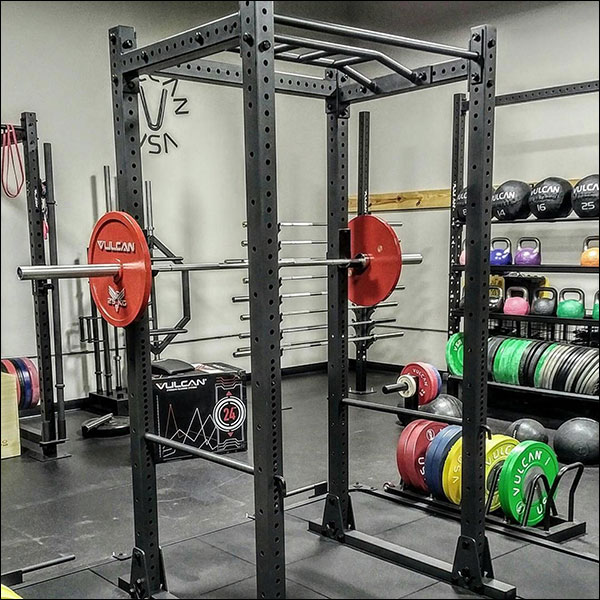
The Vulcan Flat Foot is an 3″x3″, 11-gauge steel power rack with a black powder coat finish and thick 5/8″ black zinc hardware. The horizontal feet that allow this power rack to be used unachored are attached using 10mm thick gussets, and the whole unit (feet included) has a nice, compact footprint of 48″x49″. The distance between the uprights is 36″, it features one inch hole spacing (Westside) throughout the bench region, and the rack even ships with the multi-grip pull-up bar included. All for $649 shipped.
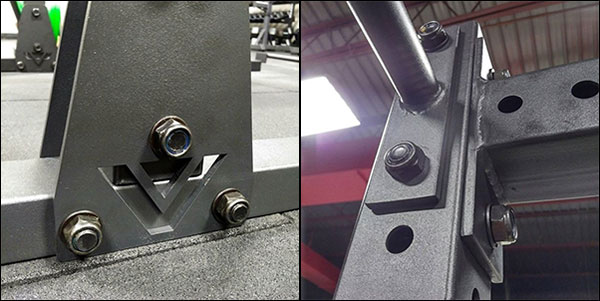
The Rogue version of this rack is the RML-390F Flat Foot, and with all the same core specs it sells for $150 more and doesn’t come with the multi-grip bar nor does it include shipping. Now I’m a huge Rogue fan, but the Vulcan is clearly a nicer deal in this case. Even better is that the Vulcan rack can accept just about any 3″x3″, 5/8″-hardware accessories, so you’re not limited by what Vulcan has available.
Now of course you could spend more than the $649 that the Vulcan Flat Foot goes for and buy a king-size rack like the RML-490C ($1075) in color or the Rep PR-5000+ ($1199), but you certainly don’t need to. You could also spend less and get a basic squat stand with pull-up bar like the S-2 for $425, but you’ll have limited accessory options and you have to add back into those savings the cost of the safety arms.
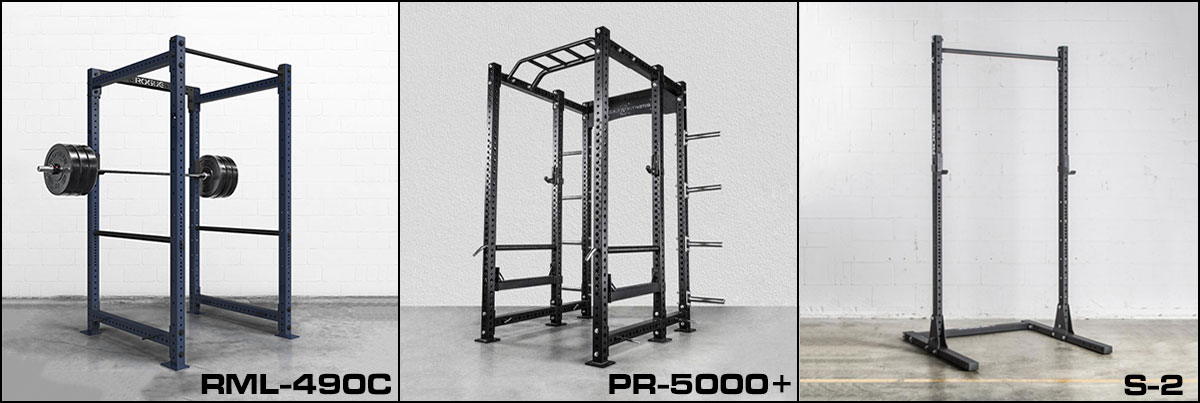
Finally, I need to mention the HR-2 for those of you who have limited space, but would like to store plates on the rack itself. The HR-2 is basically a squat stand that has an additional pair of uprights for storage. You work out in front of the HR-2 like you would any other squat stand, and it has the same small footprint as a squat stand (or the flat footed racks), but you still get the benefit of plate storage.
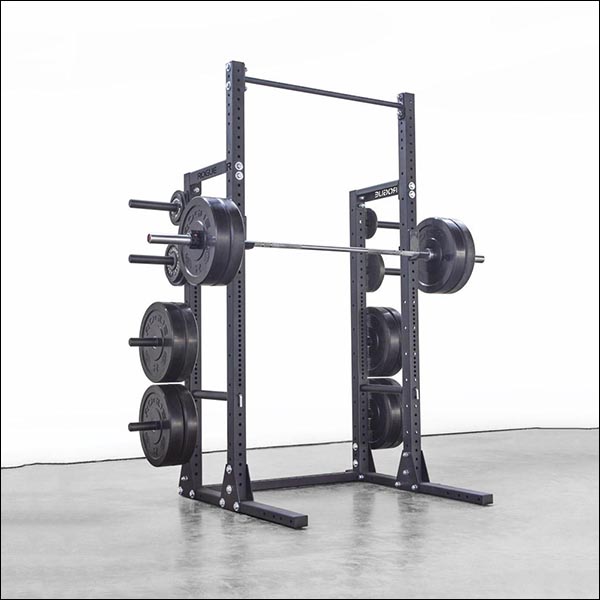
The HR-2 sells for $655, but will actually cost you over $900 before shipping once spotting arms and plate storage horns are added to your rack. It’s a fantastic product, and all things considered it is economical, but that doesn’t mean it’s affordable for everyone.
Powerlifting Garage Gym Item #2 – The Power Bar!
Well you’ve got to have a barbell, and just so happens that there are two great options for power bars that cost exactly $250 – the American Barbell Grizzly and the Ohio Power Bar.
The 20 kg Grizzly Power Bar by American Barbell
The Grizzly Power Bar is a hell of a lot of barbell for $250. First off, American Barbell makes arguably the most durable and quietest bar in the USA; perhaps even top three in the whole world. Second, the Grizzly is pretty feature-rich for so little money.
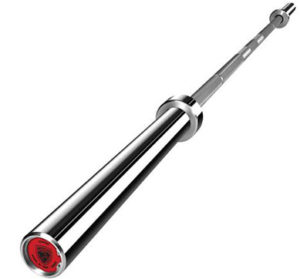
The Grizzly Power Bar is a 190k PSI, 29 mm bar with composite bushings, moderate knurl, a center knurl, and a hard chrome finish throughout. A hard chrome, 190k PSI bar for $250 is a steal, and American Barbell actually uses industrial chrome, not a decorative chrome or some other nonsense material that is then called hard chrome.
The 45-lb Ohio Power Bar
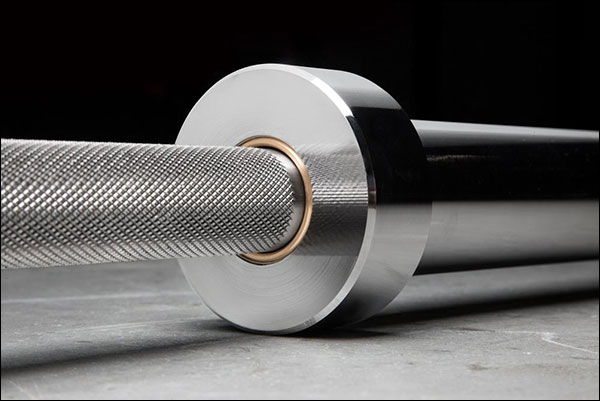
The raw steel Ohio Power Bar is also $250, and it too is one hell of a bar for so little money. It has a 205k PSI, 29mm shaft with bronze bushings, super aggressive knurling and equally aggressive center knurl, and no finish whatsoever. The Ohio Power feels exactly like what a competition power bar feels like; super sharp, super stiff, and very natural feeling (due to no finish.) It too is a very good buy.
Why Buy One Over the Over
The Grizzly Bar has a more moderate knurl, and will feel more like a gym bar than a classic, competition power bar. The knurling is more than adequate for the bench press, the center knurl is comfortable for back squats, the chrome finish will prevent any kind of rust, and it is a very quiet bar. The Grizzly is a very professional piece of equipment, and a great value.
The Ohio Power Bar will indeed more closely resemble a competition power bar. The knurl is sharp and the bare steel is grippy, but it will rust and the center knurl is absolutely brutal on the back or neck (power cleans.) The OPB is also a very loud bar, but it is a very strong and rigid bar. It’s also a very popular bar.
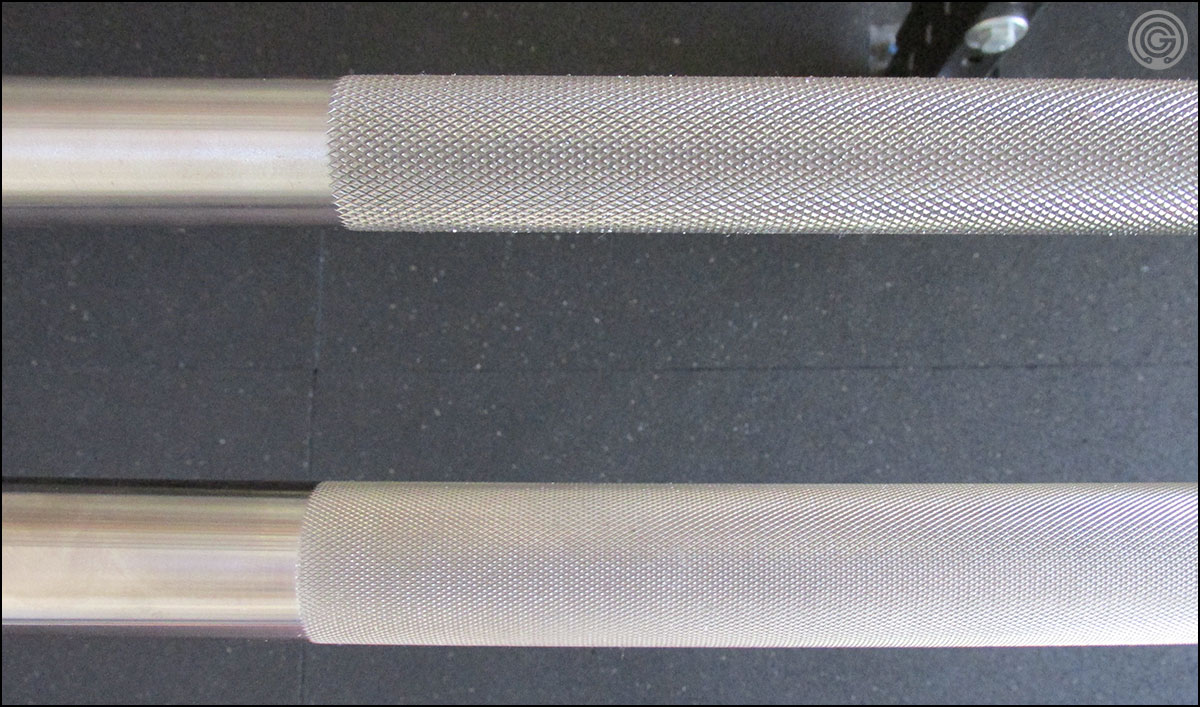
Which is best for you is up to you to decide now that you know the big differences between them. Or you could always upgrade from here [power bar guide].
Budget Alternatives
You probably shouldn’t buy anything for less than these two $250 power bars; it gets pretty bad in the sub $200 market. That’s just my professional opinion anyway.
The only decent and cheaper alternatives are perhaps the Rep Fitness Power Bar that has been heavily discounted because the hash marks are in the wrong place, or as a total “I am so broke” option, the CAP OB-86B. Neither of these bars are that good and I think you will just end up replacing them sooner rather than later. It seems smarter to me to just pay the difference now. It is, after all, your call though.
Powerlifting Garage Gym Item #3 – The Iron
I strongly suggest you check Craigslist for used machined cast iron plates before you buy anything new. I specifically say machined because machined plates are far more accurate than the cheaper, cast iron plates you’d find in a box-store like Sears, Academy, Wal-Mart, Dick’s, and so forth. Of course used because plates are a great place to save money when setting up a garage gym.
If you cannot find used machined plates in your region I recommend getting prices on two different plates; the Rep Equalizer Plates and the Rogue Machined Plates. These two are relatively affordable, machined plates with a 2% accuracy guarantee. The price per pound difference is negligible, but one may be substantially less to ship to you than the other.
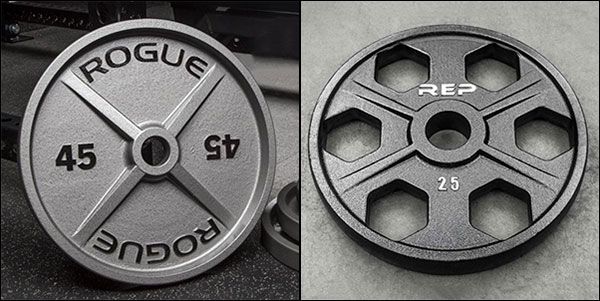
Of course you can buy nicer and more expensive plates than this if you have the budget for it; like Vulcan’s Calibrated Steel Plates; but you probably aren’t going to want to spend that kind of money.
If all you can afford is a cheap cast iron set from the local sporting good store, bring a scale with you and find pairs of like weights. Believe me, some of these cheap plates will be off by as much as 5-lbs, and you do not want a pair of 45’s with one weighing 41-lbs and the other 47-lbs. If you have to be cheap about it, at least be smart. Bring a scale!
For more options, and a more in-depth guide to choosing iron plates, see this.
Powerlifting Garage Gym Item #4 – Flat Utility Bench
Choosing a solid flat bench is pretty simple these days, as there a ton of inexpensive, high-quality options on the market. My current favorite for stability, durability, and low price is the Rep FB-5000. At only $119 for the base model, you get a beefy 3×3, 11-gauge frame, thick pad with perfect dimensions, and compatibility with Rogue’s Thompson pads. Soon enough Rep will even be offering their own economical grippy fat pad as well. It’s been tough to find this bench in stock as of late, but if you’re not in a hurry it might be worth waiting for.
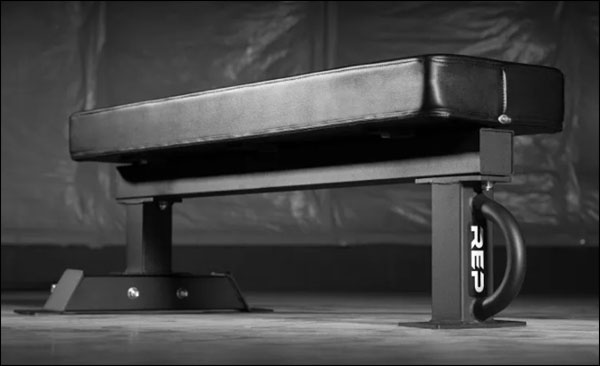
Another solid alternative is the tried-and-true Rogue Utility Bench. It’s a little pricier but it’s a beast of a bench, and the neoprene pad and commercial-grade vinyl is not something you’ll find on the economy benches, and not even on many benches that cost a whole lot more. It sells for about $179 and has over 80 5-star reviews.
The Rogue Utility has always been my number one suggestion; tied with maybe the Vulcan Flat Bench; which will show up at your door for a hint less than the Rogue. The introduction of Rep’s FB-5000 doesn’t diminish the value of these benches, but it does add a third major contender. Rep has even cheaper flat bench than the 5000; the FB-3000; but I’m much less of fan of that particular bench.
Be careful with cheapo benches. You do not need a $400 flat bench from Cybex or Legend, but the cheaper box-store benches have godawful padding, thin vinyl, and light-gauge steel frames held together by cheap bolts. They won’t hold much weight, they won’t sit flat all the time, and you’ll just end up trashing it and buying a better bench anyway.
Powerlifting Garage Gym Item #5 – Deadlift Platform
Unless you want to crack your foundation you’ll need something to deadlift on. The easiest, cheapest solution to creating a deadlift spot is to buy two 4’x6′ horse stall mats from Tractor Supply Company and set them side-by-side. This will set you back about $80 and give you plenty of space for deadlifts (exactly 6’x8′). These mats are 3/4″ thick and do a fantastic job of protecting your foundation. Without a frame of some sort they will shift and slide around a bit though, so consider one of these other options.
The next best option is to DIY a lifting platform. This requires 5 sheets of 4’x8 plywood and two horse stall mats that will be cut into strips. This will set you back $200-$300 and take a good half-day to complete, but it will give you a very permanent spot for deadlifts. The final dimensions will be 8’x8’x2.25″. There are countless online guides to putting a lifting platform together so I won’t get into all that here. Google that one.
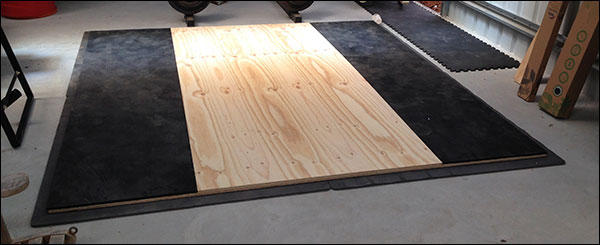
Image credit: Ultimate Man Cave Build
Finally you can just buy a lifting platform. This is obviously the easiest method, but also the most expensive. Rogue has a very reasonable price on their 4’x8′ Deadlift Platform. All told it would cost you about $600 to buy the frame and the rubber tiles, or you could spend $367 on the frame and line it yourself with a sheet of plywood and your own horse stall mats.
Needless to say there are more exotic pre-built lifting platforms on the market. Building your own platform, and perhaps even building it to be 4’x8 instead of the standard 8’x’8′ is likely ideal if you’re trying to keep the price down. 4’x8′ is plenty of space for deadlifts and cutting the platform in half will cut the construction price nearly in half as well.
Optional Powerlifting Equipment
Based on your own particular needs or training goals you might need a little more than the core basics. Here are some of the more common powerlifting items along with some high-quality, relatively low-cost recommendations.
Keep in mind this section is less thorough than the above section. My suggestions are just that; suggestions. There are, of course, other options. If I have a more in-depth article on a particular item, I will link to that so you can do some additional research.
Safety Squat Bar
The Safety Squat Bar (SSB) is an exceptional specialty bar for building up your squat with squat-specific movements. The SSB puts the load midway between a front squat and back squat, and is an excellent implement to use when performing box squats.
You can get pretty carried away with the SSB in terms of how much money you can spend, but I personally just ended up going with the Vulcan SSB because it had standard Olympic sleeves with bushings, a hard chrome finish, and it weighs the same 20 kilos as any other regular barbell. Also it wasn’t that expensive compared to many other SSBs ($260).
Deadlift Bar
The deadlift bar is one of the few pieces of specialized equipment that I would truly miss if I didn’t have it. Deadlift bars like the Ohio Deadlift Bar make for fantastic second barbells in a powerlifting garage gym because a) the thinner 27 mm shaft, the extra shaft length, and the aggressive knurling really make for a great deadlift bar, and b) owning a dedicated deadlift bar allows you to pick a power bar with toned down knurl since you won’t be pulling with it.
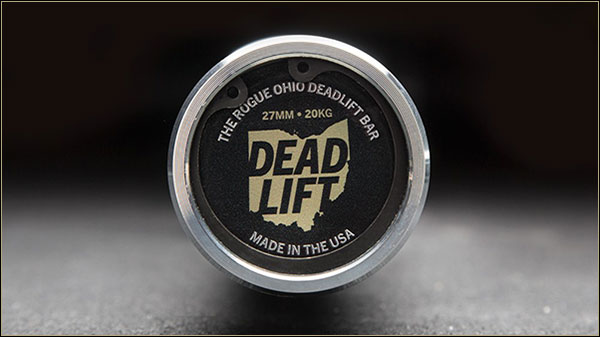
Basically what I am saying is that the super aggro knurling that’s found on most power bars is there for the deadlift; it’s unnecessary for squats and bench press. Sure it is tolerable for those two lifts, but in the case of bars like the Ohio Power Bar where the center knurl is just as sharp as the outer knurl, the bar actually kinda sucks for back squats and power cleans.
I own the Ohio Power Bar and an Ohio Deadlift Bar. I use the Deadlift Bar exclusively when it comes to deadlifts, but I almost never use the Ohio Power Bar over the more moderately-knurled American Barbell Power Bar * for squats, rows, and presses. I don’t mind pressing the Ohio, but as a high-bar squatter I won’t squat with it – it hurts.
At the end of the day if your budget is tight and you’ll only be buying one bar, then buy the one that is best for you. I’m only suggesting that if you plan to buy two bars, or are already addicted to deadlift bars because of the elasticity, then perhaps you could at least re-think your position on aggro knurled power bars when you know they won’t be being pulled.
* I lift on a discontinued bar; the AB Super Power Bar. It’s basically the Mammoth without the Cerakote. ALL American Barbell bars have the same knurl though, so if you wanted an AB bar for the reasons I’ve outlined then any AB power bar would suffice; Elite, Grizzly, Mammoth, etc.
Adjustable Incline Bench
A flat bench is a garage gym necessity; no doubt about that. Luckily a good flat bench isn’t all that expensive; at least relative to what nice barbells, weight sets, and power racks cost. Still, many folks believe they need the more expensive adjustable incline bench rather than just a flat bench, and while I will admit the incline bench is a great thing to have, it probably isn’t as important as the flat bench.
Be that as it may, I’ve learned that most people are willing to spend the money required to own an incline bench. Most will even go so far as to own both a flat and an incline bench; being that adjustable benches don’t usually make good flat benches. So here are a couple of the better incline bench options out there.
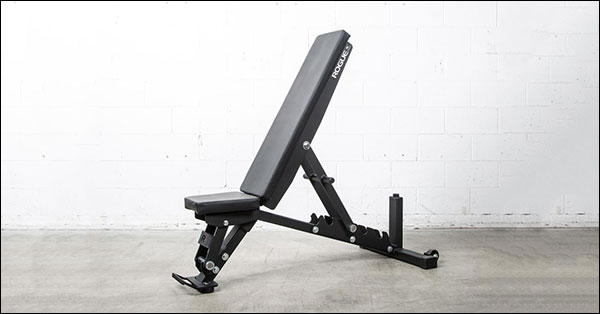
The Rogue Adjustable Bench 2.0 is a $545 flat/incline bench with 2 seat settings and 6 pad settings ranging from 0º to 85º. This bench has a fairly wide pad for an incline bench at just over 11″, and it features a very minimal gap between the seat and pad that makes it one of the only incline benches comfortable for heavy, flat bench presses. While I personally think the single incline seat position is weak, I realize that I may be alone on that because this is a very popular, highly reviewed bench.
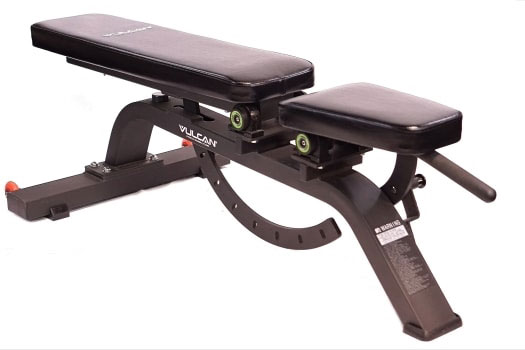
The Vulcan Pro Incline Bench is a beast of an adjustable bench; modeled after the $1000+ Precor Super Bench that you find in commercial gyms. The Vulcan Pro has 5 seat positions and 7 pad positions ranging from 0º to 90º (including 85º.) While this is one of the highest-quality & lowest priced adjustable benches out there, it suffers where most incline benches suffer – a large gap when the bench is in flat mode. $649 shipped.
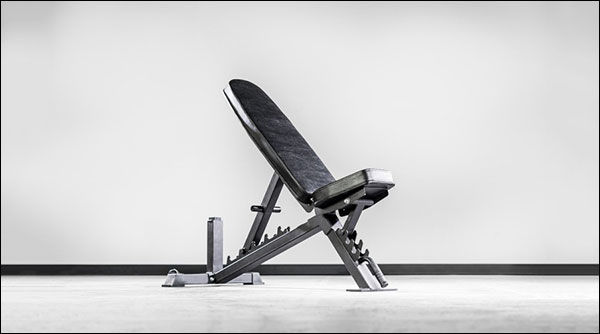
The Rep Fitness AB-3100 Adjustable Bench is one of your better economical incline bench options. It features 3 seat settings and 6 pad adjustments that range from 0º to 85º, a nicely sized and shaped pad, but this bench still has that typical 2″ gap between the pad and seat when positioned flat. This isn’t a bad option on a budget, but you’ll find the vinyl isn’t as nice as the Rogue benches and that the padding isn’t quite as firm. Still, this is like half the price of the Rogue 2.0.
For more bench options take a look at my comprehensive bench buyers guide.
Box Squat Box
I’m lucky enough to be tall enough to be able to do box squats on an 18″ high utility bench (you can see that image above in the safety squat bar mention), but if I were not able to do that I would definitely invest in an adjustable box squat box. Box squats are one of the best squat-specific movements in a garage gym. It’s a very affordable way to add variety to your leg training without needing to own expensive machines like the leg press or leg extension.
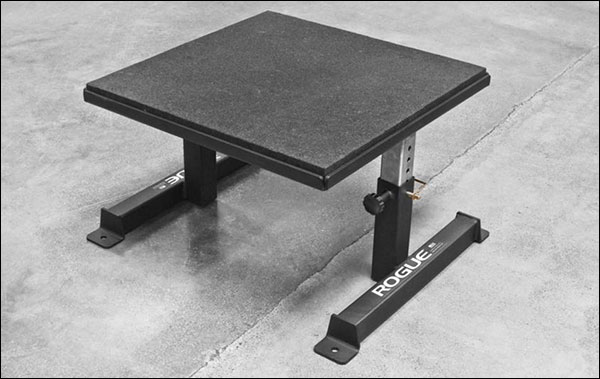
The above Box Squat Box from Rogue is nice; well-built and adjustable; but it’s a bit pricey. Buying one of these is an easy solution, but you could technically build a box to the perfect height for you for way, way less money. Some companies like Rep Fitness have adjustable metal plyo boxes that may serve as a decent squat box, but the adjustments are pretty big (4″ versus 2″ jumps). Either way, very useful and relatively inexpensive piece of equipment.
Monolift Attachment
Many of you will want Rogue’s Monolift Attachment for your power rack, which I think is an acceptable rack accessory to have if it’s within your budget. The monolift will ease lift-off in the bench press, and eliminate the walk-out in the back squat; making for a safer lift in both cases (assuming you aren’t neglecting your safeties, that is.)
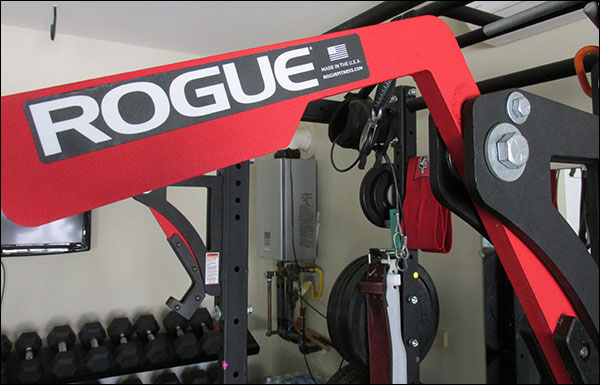
If you purchase the monolift attachments I recommend going for the adjustable variant, not the bolt-on. Installing and uninstalling the bolt-on version is not difficult by any means, but if you move the hooks around often enough it will get old very, very fast. If you share you gym with people who don’t want to use the monolift or are of a different height, it’ll get even more annoying. Seriously, spend the few bucks to get the adjustable model. [mono review]
Things You Probably Don’t Need
There are some pieces of equipment that you may think you need; probably from watching various YouTube channels or reading review sites like this one; but probably don’t need at all. Here are a couple of examples of products that you probably don’t need to budget into your garage gym anytime soon.
Glute Ham Developer
The GHD is a very large piece of equipment with limited usefulness. Some people swear by it while others think it’s a total waste of gym space. I am actually still on the fence about this despite the fact that I’ve had my GHD for many years now. Here are the issues:
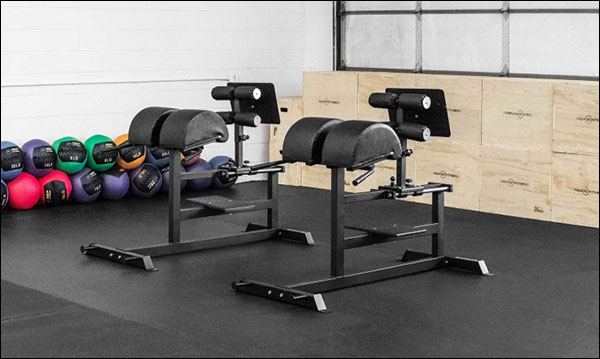
First of all the GHD is not all that versatile of an item. Not only are there just a few exercises that can be done on a GHD, only one of them actually requires that you own a GHD. That is to say, you can do back extensions and ab exercises on the GHD but you can just as easily do them without it. Really it’s only the Glute Ham Raise (GHR) that actually requires a GHD to perform.
Couple this limited usefulness with the high price of a decent GHD and the square footage required to house a GHD in a garage gym, and you have a fairly low overall value piece of equipment. There is definitely benefit to the GHD and the GHR, but I suggest you make damn sure you really need one before you sacrifice the money and the space to have one. Good mornings are a solid movement, and they are an acceptable alternative to the GHR.
Reverse Hyper
The Reverse Hyper is very much like the GHD in that it has very limited usefulness for most of us, takes up a shit load of space, and will set you back several hundred dollars if you can find a used one and as much as $1000 to buy it new. I strongly suggest that you read up on and research the Reverse Hyper and what it’s used for before you buy it. If you have back issues and you already know a Reverse Hyper is for you, then by all means get one. That’s not most people though.
To put this all another way, if the Reverse Hyper and the GHD are not already part of your current programming, get them off your radar until they become a necessity – if they ever become a necessity.
Dedicated Bench Press
Don’t buy a dedicated bench for a garage gym unless you’re loaded and have like a 3-car garage dedicated to your gym (in which case you’re not reading this “economical guide to building a powerlifting gym” anyway.) Your power rack is already a bench station.
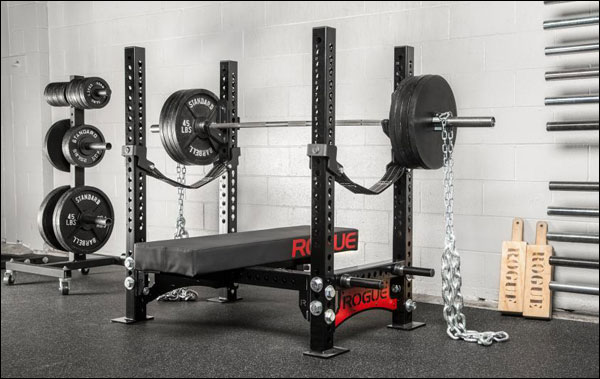
I know these things are badass, but talk about a giant waste of space for a garage gym.
Dumbbells
I believe dumbbells are a great addition to a garage gym, but I think they should be ignored when first getting set up unless you’ve got several thousand to spend, not a limited budget. When it comes time to buying dumbbells, see my dumbbell guide here.
Powerlifting Garage Gym – Summary
In an effort to keep this article from getting even longer still I’ll leave off smaller accessories like bench blocks, Slingshots, chains and bands, and so forth. You know whether you need those things or not, and they don’t require a lot of explanation.
Since there are always limits on how specific I can get in long articles like this, I invite you to comment below or email me directly if you have a question that has not been addressed here. You will also find tons and tons of more specific information on my equipment guides and reviews; which you can find linked to in the menu at the top of the page. Please share this post; it helps me a lot.
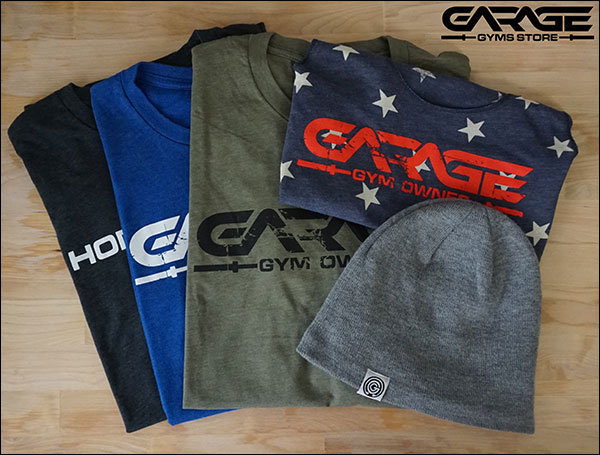

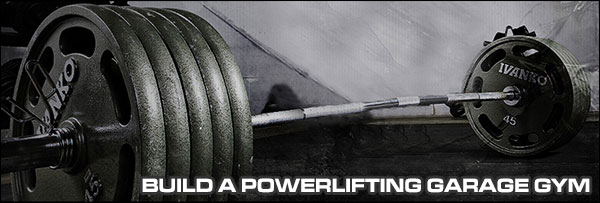
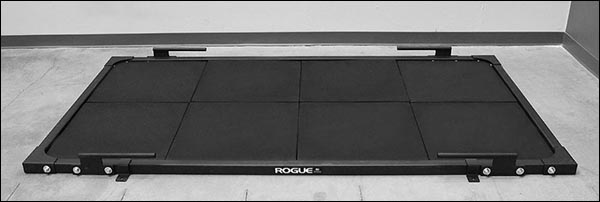
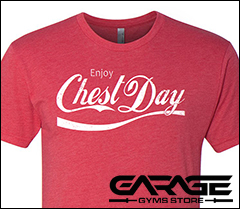
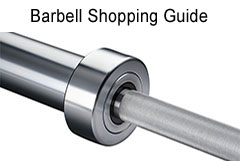
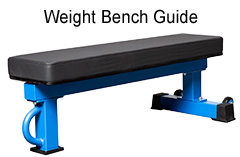
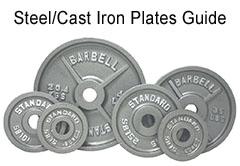
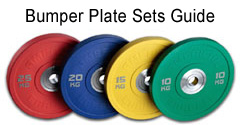
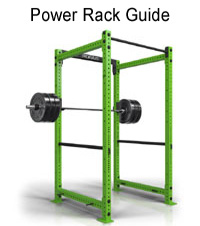
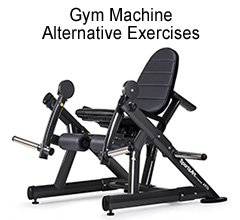

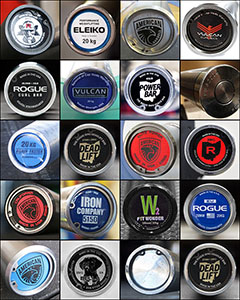

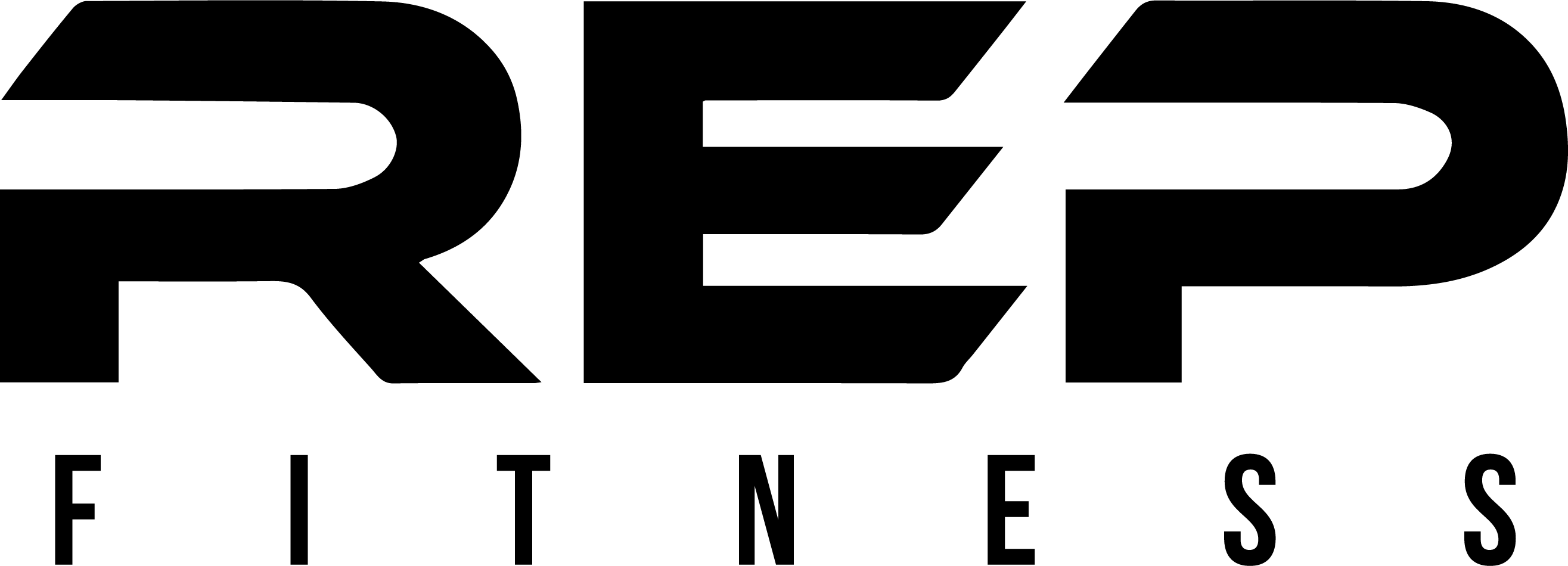
*points to the picture of the man box squatting while wearing a ‘belt’* ;)
haha I like that belt; gotta represent it any chance I get =p
Great advice in this article. I recently incorporated box squats into my training, and while I can use my bench, I think I’d be better off with something a few inches lower. I saw the Rep Fitness adjustable box, but agree that it’s 4″ increments make it not ideal for box squats, and I doubt anyone is using a box squat at 24″ either. My solution will probably be a metal 12″ plyo box and just use the 1.5″ regupol tiles I use for deadlifts to adjust the height. I’m also short so there’s that.
By the way those regupol tiles from Rogue are super handy. If you have 3-4 of them you basically have a portable deadlift platform, you can do deficit pulls, whatever the opposite of deficit pulls are, you can adjust the height of your bench or your feet when benching (I don’t have a super tall bench but think they would be great for those with the SuperBench for example), they are great as a landing pad for heavier kettlebells and sandbags, etc. When you’re done they can lean against the wall and take up hardly any space. Highly recommend.
Thanks Tony. Yeah I think I’m just barely tall enough for the bench. I’m glad that works out though so I don’t have to buy/store a box… Normally I’d chalk that up to a review but, well, how interesting would a box review be without having a few of them to at least compare to.. and even still haha.
Yeah the tiles are nice. I actually have older stall mat pieces cut down for that very reason – deficit pulls mostly. I would like some of the 1.5″ thick mats though – seems more convenient. Also it’s a nice substitute for using plates to raise pulling blocks height (either for actual pulls, or some people will use pulling blocks for the box squats).
All great feedback, as always. Thank you.
I train only for powerlifting and have my own gym. A lot of stuff I made myself. My list of gear to get which is a touch different:
Squat/Bench combo rack. Plus side over a power rack is that it’s easier to move around, it’s what you use in comps (train like you compete philosophy) and it has everything you need. Cons are that there are lots more add ons for a power rack, but i find I don’t need any of those. Get one with proper safety bars that wrap around the uprights. A real flat bench is included so no need to buy one. Sit it on a 3m x 3m platform and you have your squats, bench and deadlifts all set to go.
Calibrated plates. Don’t screw around. Get real calibrated steel powerlifting plates. There are some cheaper varieties available now so prices should reduce overall during the next few years. No need for IPF approved, just make sure they are calibrated within IPF specs. I use Eleiko plates but you can get some cool Vulcan or Strongarm.
Barbell. Again, don’t screw around. Get a real IPF spec bar. If you sell it (and your plates) down the track you will get much more than cheaper gear, plus a barbell is the heart and soul of your training. Give up beer and pizza for a few months and buy an Eleiko or similar IPF approved. Skimp on dumbbells and other accessory stuff but don’t skimp on bar and plates. You just need one bar, skip the deadlift bar for now, especially if you are an IPF lifter. Having a bar that makes it easier to deadlift will kill you when it comes to a comp when you use a stiff comp bar.
Plate storage: make your own or buy if you have the funds. I have two dish racks that I made, one each side of the platform. A wall mounted system is easy to make out of wood. Lots of “how to” vids on Youtube.
Pull up bar. I made mine or buy a decent one off Amazon.
An incline bench.
A GHD. Contrary to the article, it’s far more important than a squat box (which you don’t need if trying for raw comps). You get accessory hamstring training, hypers, ab work and dips. Great value for the space it takes up.
Less important but handy is a basic cable tower. Some nice compact ones out there. This is for triceps, biceps, abs, rows, pull throughs, etc. Worth the space, not that they take up much room.
Chalk bin, a couple of kettlebells, a loud stereo system, something to sit on between sets and you are good to go.
Just my version/opinion. If you aren’t competing and never intend to, the above article is fairly accurate.
Looking for your opinion…
I have changed my garage gym setup a time or two (from a squat rack to a 6 post power rack now to an R-3). I had a GHD 2.0 that I sold off. Various other things.
What I have now:
Rogue R-3 (2 pair J-cups) w/ regular pins/pipes
Rogue Flat Utility Bench 2.0
Rogue Ohio Power Bar (bare steel)
Rogue Castro bar (bare steel)
Rogue Curl bar (e-coat)
Troy PO Plates (775 lbs)—12 45s, 4 25s, 8 10s, 8 5s, 6 2.5s
Fringesport Bumper plates (260 lbs)
Rogue Calibrated change plates (2 pr. 0.5kg, 1 pr 0.25kg)
2 Plate trees holding all 1000+ lbs
Rogue vertical 3 bar hanger
Concept 2 Model D Rower
Ironmaster Lat Pulldown / Row stand-alone machine w/ different attachments
Rogue kettlebells—18, 26, 35, 44, 53 lbs
Rogue Monster bands (#3, #4, #5)
Rogue Post Landmine w/ parallel and straight handle
Titan single landmine handle
Titan Full Deadlift jack
Your article has good suggestions beyond the basics. I’m not into Crossfit….just powerlifting, really. Should I start looking at the ancillary stuff (SSB, deadlift bar, squat box, monolift attachments, ironmaster dumbbells, adjustable bench, etc.)?
Any new opinions on dumbbells? I am thinking of the Ironmaster kit, but you referenced a lot of newer stuff (ie. Rep has urethane now, Vulcan has the Pro rubber hex dumbbells, etc.).
To add on for context….
I’ve had to reset my Novice LP (SS), but am nearing the end of that program heading into more intermediate programming (including some variation from the comp lifts). Any advice on where to go from here?
The deadlift bar probably isn’t necessary, but it is intriguing solely from the 27mm thickness standpoint (not as much regarding whip). I’m not doing crazy weight right now, but I may benefit from the 27mm vs the 28.5 Castro bar I use currently. I keep my OPB for squatting and pressing.
Your set up is very nice – very complete.
A squat box will come in handy with intermediate programming, as will a safety squat bar. Squat boxes are almost always DIY’d just because it’s easy to do, but you can buy one. An SSB doesn’t have to be a $400 buy either – I use Vulcan’s fairly simple and basic version. Many people like to go all out on the SSB and that’s fine too if you want. It is worth having though in my opinion. I love having a deadlift bar but it’s not as though you can’t deadlift without one.
Most of this stuff is optional of course. Mono, the other accessory bars, even dumbbells. It’s all nice to have, but there’s very little you can’t do with what you already have. That said, I’d be very unhappy to not have an incline bench so that may be worth adding for the chest and shoulder variety.
I love Vulcan’s new Pro dumbbells, but those mugs are expensive in pairs and most people aren’t going to buy a full set. If fixed dumbbells are out of the question because of price, then Ironmaster is the way to go.
I’m looking for new programming myself, but I was using GZCL for like the last 18 months. Pretty solid… that’s a long time to be happy with a program I’d say.
Thanks, I appreciate your time and thoughts!
That makes a lot of sense. I also forgot about other conditioning stuff. Maybe the priority will be:
Rogue Echo Bike and/or Butcher V2
Safety squat bar
Squat box
Incline bench
Ironmaster dumbbells
Deadlift bar
Etc.
I think I may add some safety straps for my R-3 for squats, rack pulls, etc. Maybe get a Matador and dip belt (also for weighted pull ups). Those are in intermediate-land too.
Of course, I still think about the Monster shorty bench with Fat Pad, Calibrated KG plates, and other standard or accessory bars.
I saw that Rogue sold the 459kg set on Black Friday for $2000 (minus $660 HUNDO). I have serious doubts they’ll do that again, but it would be hard to resist if they did (even though my plates are super accurate).
Forgot to say that I have a nice deadlift platform already too. May add band pegs to it at some point.
I bought my plates on during the Black Friday pre-sale, so I got the free shipping but not the Hundo pricing. Who woulda guessed they’d end up on the Hundo list!
I actually still think they were never supposed to have Hundo pricing – that it was an oversight that was corrected when noticed. a) because they were pulled from that Hundo pricing in less than a day (before I could pull the trigger on more plates, of course) and b) cause selling $2000 worth of plates that do not include free shipping for $1000 ($1340 minus Rogue’s cost to ship cause of MBF) just doesn’t make sense. Anyone who scored a $2000 set shipped for $1340 really won the jackpot.
Don’t buy Titan straps lol. Danger!
LOL! I’m not a Titan fan. My full deadlift Jack is actually pretty decent, but I only bought it because it’s not anything that could hurt me if it breaks. I think I paid $67 shipped for it. I’d never buy a Titan rack or anything that needs to be safe. I just don’t think saving a few bucks matters over the benefit of having safe, quality gear when you consider it’ll last the rest of my life.
I agree concerning the HUNDO thing; however, I’ll be tuned in to see if lightning strikes twice on that. I really would buy them if another deal pops up. If not, it seems the Vulcan plates are another great option and have free shipping (at least currently).
I’m really happy with my Troy plates. I paid $1.15 per pound for 775 lbs. No tax and picked them up in Houston. I’d say the accuracy is generally within 1%. I could go back and check the grams on the little plates. All of my 25 and 45s are matched to tenths. My pairs are 45.3-45.3, 44.9-44.9, 44.4-44.5, 45.2-45.1, 45.3-45.6, and 44.9-44.6. Essentially, I have two perfect matches, two 0.1 mismatches and two 0.3 mismatches. So…as long as I have at least two pairs on, I’ll never be out of balance. It’s not perfect, but I can essentially always keep them balanced. My 25s match up perfectly, and all of the smaller plates are a differences of grams (not ounces).
I forgot to say…The best part of the Troy plates is that they fit REALLY well on the 45s and 25s. I’ve found the smaller plates fit slightly looser. I really only care because a tight fit is great for deadlifting. I also like the look and feel of the old deep dish style plates.
I just checked to see if there was free shipping on those Vulcan plates and they did not. I was about to make some pre-sale purchases lol. Yeah I’ll be watching Rogue on BF too for that same Hundo thing. I doubt it, but I’ll be on it.
Your Troy plates great. I’d keep those forever
Double check Vulcan. I saw that the SETS of calibrated plates are on sale. Maybe not the pairs. I have a 459kg set in my cart for $1881.99 with free shipping.
Thanks, I will keep the Troy’s for sure. Nothing fancy, but they work. Still, I may end of with a KG set in the next year or two.
Cheers!
jordan
Oh I only checked pairs. You’re right. Interesting
Awesome! Haha. They look super cool. Wish they would post pics of what the smaller plates look like (e.g. Rogue’s are chromed).
Thanks for these great reviews. I’ve got a new gym coming from Vulcan thanks to you.
Went with the Vulcan flat foot rack mentioned above, 340# of Alpha bumpers and their Absolute SS power bar. Getting it all together as a package knocked almost $200 off the price, which was enough savings for me to splurge on a premium bar. There’s a link to the bar&plates combos on their website page for the rack.
https://www.vulcanstrength.com/Bumper-Plates-Olympic-Bar-Sets-s/91.htm
Pick your combo and you can add the rack (among other options) before you drop it all in your shopping cart. I don’t think you can get the same price by adding everything separate and I didn’t see the combo link in their menu.
Oh yeah, almost forgot: bought a few shirts from your store as a way to say “thanks!”
Thanks Robert. I appreciate that!
I’ve been looking to get a flat foot rack because I can’t bolt down in my garage at this point and I can’t really find any information on the Vulcan FF other than the couple paragraphs you have on here. Anyone have any experience with it or how it compares to the rogue ff or even the x3 over time? Thanks and amazing site btw, so much info on here, you’re a beast.
haha thanks Erick.